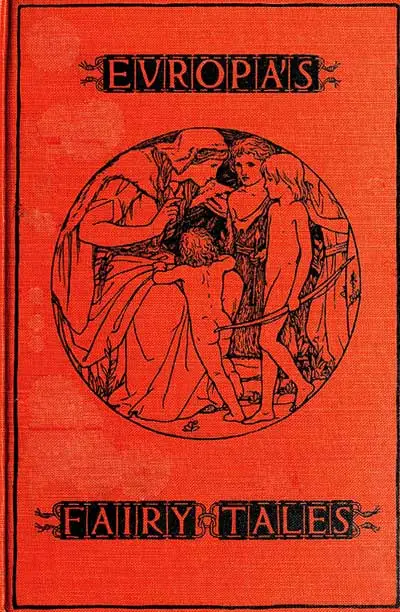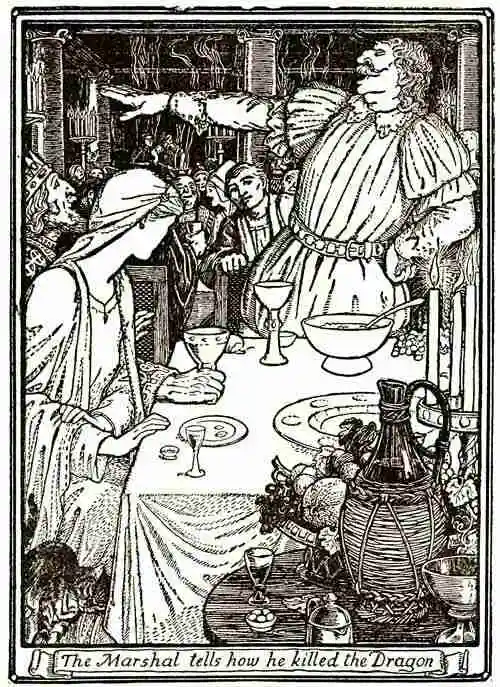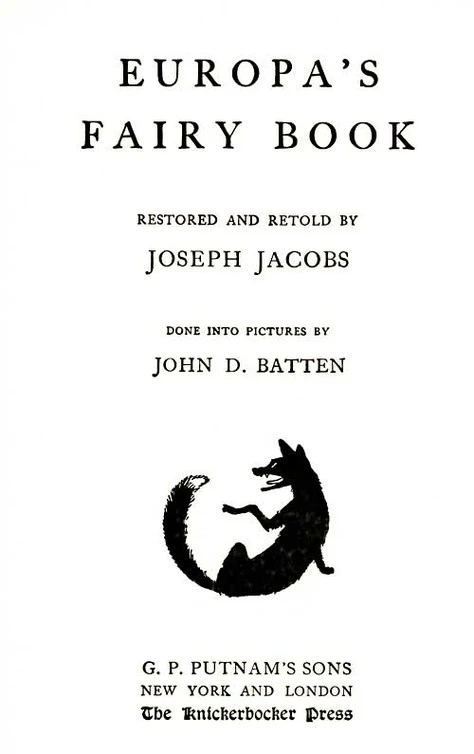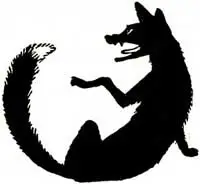Europa's Fairy Book
The Project BookishMall.com EBook of Europa's Fairy Book, by Joseph Jacobs
This eBook is for the use of anyone anywhere at no cost and with
almost no restrictions whatsoever. You may copy it, give it away or
re-use it under the terms of the Project BookishMall.com License included
with this eBook or online at www.BookishMall.com.net
Title: Europa's Fairy Book
Author: Joseph Jacobs
Illustrator: John D. Batten
Release Date: July 10, 2008 [EBook #26019]
Language: English
*** START OF THIS PROJECT BookishMall.com EBOOK EUROPA'S FAIRY BOOK ***
Produced by Sankar Viswanathan, David Edwards, and the
Online Distributed Proofreading Team at http://www.pgdp.net
(This file was produced from images generously made
available by The Internet Archive)

"Do tell us a fairy tale, ganpa."
"Well, will you be good and quiet if I do?"
"Of course we will; we are always good when you are telling us fairy tales."
"Well, here goes.—Once upon a time, though it wasn't in my time, and it wasn't in your time, and it wasn't in anybody else's time, there was a——"
"But that would be no time at all."
"That's fairy tale time."


EUROPA'S
FAIRY BOOK
RESTORED AND RETOLD BY
JOSEPH JACOBS
DONE INTO PICTURES BY
JOHN D. BATTEN

G. P. PUTNAM'S SONS
NEW YORK AND LONDON
The Knickerbocker Press
Copyright, 1916
BY
JOSEPH JACOBS
To
Peggy, and Madge, and Pearl, and Maggie,
and Marguerite, and Peggotty, and Meg,
and Marjory, and Daisy, and Pegg, and
MARGARET HAYS
(How many granddaughters does that make?)
My Dear Little Peggy:—
Many, many, many years ago I wrote a book for your Mummey—when she was my little May—telling the fairy tales which the little boys and girls of England used to hear from their mummeys, who had heard them from their mummeys years and years and years before. My friend Mr. Batten made such pretty pictures for it—but of course you know the book—it has "Tom, Tit, Tot" and "The little old woman that went to market," and all those tales you like. Now I have been making a fairy-tale book for your own self, and here it is. This time I have told, again the fairy tales that all the mummeys of Europe have been telling their little Peggys, Oh for ever so many years! They must have liked them because they have spread from Germany to Russia, from Italy to France, from Holland to Scotland, and from England to Norway, and from every country in Europe that you will read about in your geography to every other one. Mr. Batten, who made the pictures for your mummey's book, has made some more for yours—isn't it good of him when he has never seen you?
Though this book is your very, very own, you will not mind if other little girls and boys also get copies of it from their mummeys and papas and ganmas and ganpas, for when you meet some of them you will, all of you, have a number of common friends like "The Cinder-Maid," or "The Earl of Cattenborough," or "The Master-Maid," and you can talk to one another about them so that you are old friends at once. Oh, won't that be nice? And when one of these days you go over the Great Sea, in whatever land you go, you will find girls and boys, as well as grown-ups, who will know all of these tales, even if they have different names. Won't that be nice too?
And when you tell your new friends here or abroad of these stories that you and they will know so well, do not forget to tell them that you have a book, all of your very own, which was made up specially for you of these old, old stories by your old, old
Ganpa.
P.S.—Do you hear me calling as I always do, "Peggy, Peggy"? Then you must answer as usual, "Ganpa, Ganpa."
PREFACE
Ever since—almost exactly a hundred years ago—the Grimms produced their Fairy Tale Book, folk-lorists have been engaged in making similar collections for all the other countries of Europe, outside Germany, till there is scarcely a nook or a corner in the whole continent that has not been ransacked for these products of the popular fancy. The Grimms themselves and most of their followers have pointed out the similarity or, one might even say, the identity of plot and incident of many of these tales throughout the European Folk-Lore field. Von Hahn, when collecting the Greek and Albanian Fairy Tales in 1864, brought together these common "formulæ" of the European Folk-Tale. These were supplemented by Mr. S. Baring-Gould in 1868, and I myself in 1892 contributed an even fuller list to the Hand Book of Folk-Lore. Most, if not all of these formulæ, have been found in all the countries of Europe where folk-tales have been collected. In 1893 Miss M. Roalfe Cox brought together, in a volume of the Folk-Lore Society, no less than 345 variants of "Cinderella" and kindred stories showing how widespread this particular formula was throughout Europe and how substantially identical the various incidents as reproduced in each particular country.
It has occurred to me that it would be of great interest and, for folk-lore purposes, of no little importance, to bring together these common Folk-Tales of Europe, retold in such a way as to bring out the original form from which all the variants were derived. I am, of course, aware of the difficulty and hazardous nature of such a proceeding; yet it is fundamentally the same as that by which scholars are accustomed to restore the Ur-text from the variants of different families of MSS. and still more similar to the process by which Higher Critics attempt to restore the original narratives of Holy Writ. Every one who has had to tell fairy tales to children will appreciate the conservative tendencies of the child mind; every time you vary an incident the children will cry out, "That was not the way you told us before." The Folk-Tale collections can therefore be assumed to retain the original readings with as much fidelity as most MSS. That there was such an original rendering eminating from a single folk artist no serious student of Miss Cox's volume can well doubt. When one finds practically the same "tags" of verse in such different dialects as Danish and Romaic, German and Italian, one cannot imagine that these sprang up independently in Denmark, Greece, Germany, and Florence. The same phenomenon is shown in another field of Folk-Lore where, as the late Mr. Newell showed, the same rhymes are used to brighten up the same children's games in Barcelona and in Boston; one cannot imagine them springing up independently in both places. So, too, when the same incidents of a fairy tale follow in the same artistic concatenation in Scotland, and in Sicily, in Brittany, and in Albania, one cannot but assume that the original form of the story was hit upon by one definite literary artist among the folk.
1 comment